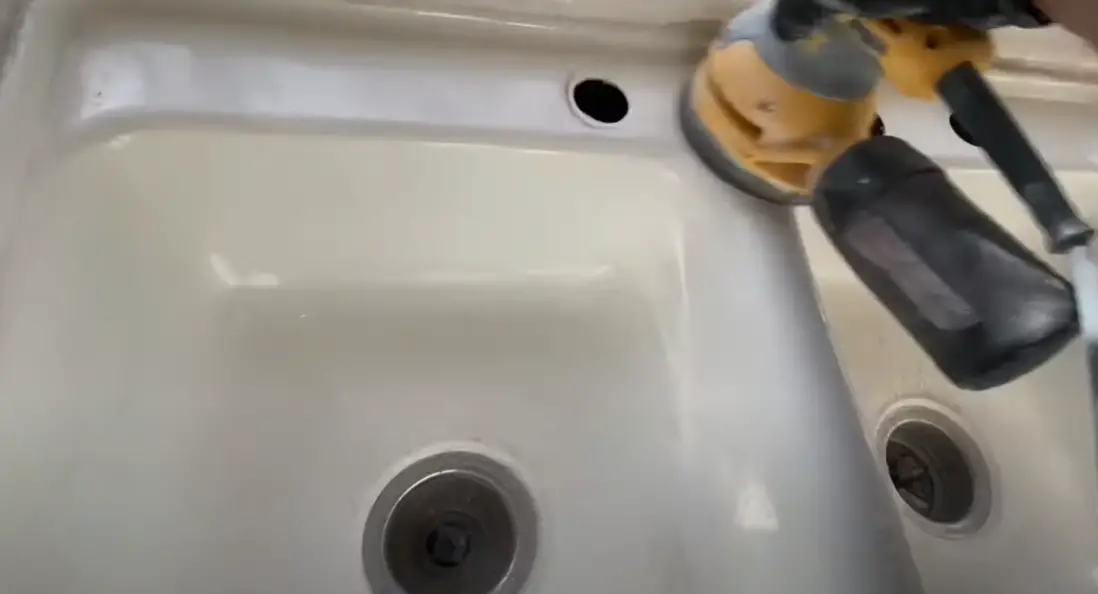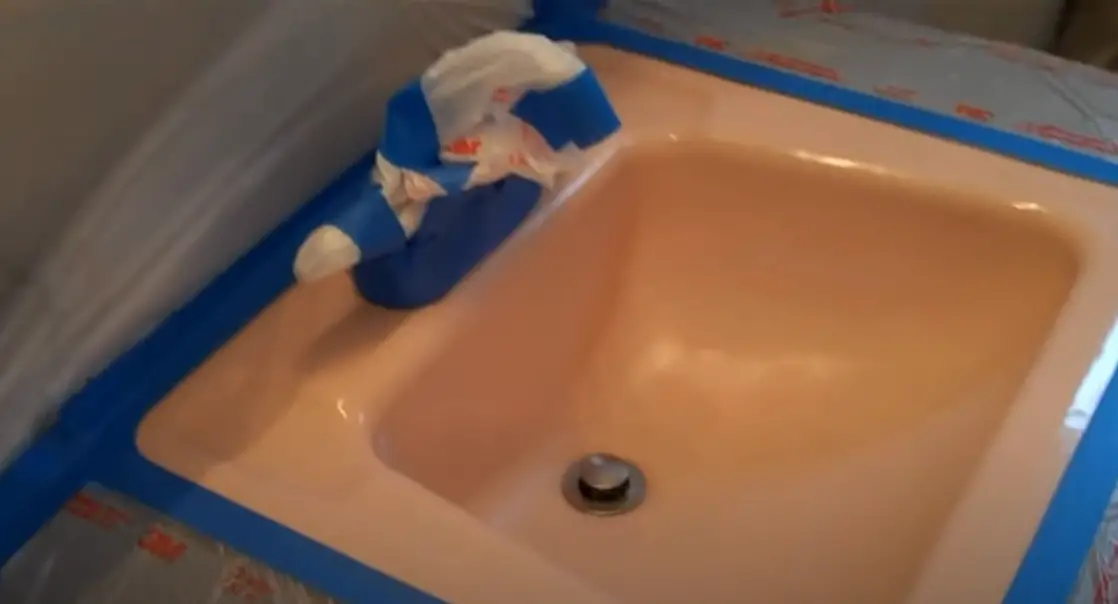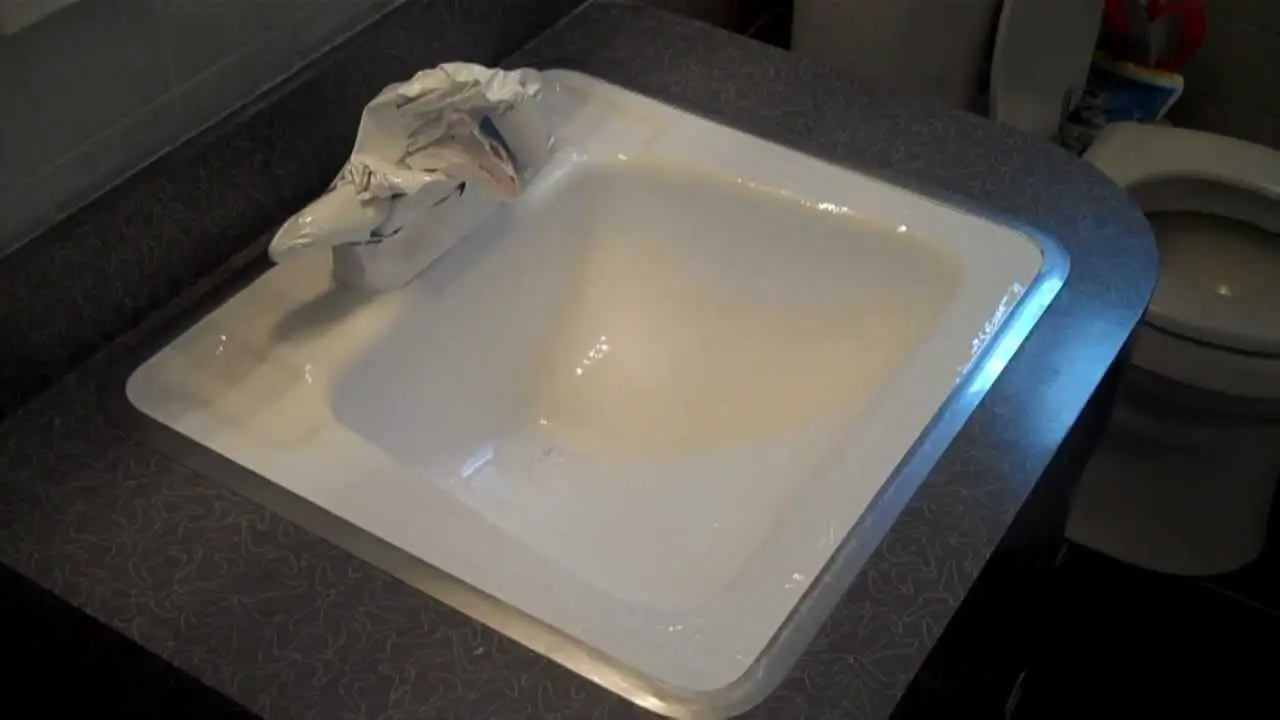Are you looking to spruce up your bathroom but don’t want to spend a fortune on new fixtures? Painting a porcelain sink could be the perfect solution. Porcelain sinks are often found in bathrooms, and they can easily become outdated or chipped over time. With the right tools and materials, painting a porcelain sink is an easy DIY project that anyone can do. It’s also much cheaper than replacing the entire fixture! In this article, we’ll explore how to paint a porcelain sink so that it looks like new again. We’ll discuss what materials you need for the job, as well as step-by-step instructions for prepping and painting your sink. So if you’re ready to take on this fun home improvement project, let’s get started!
Reasons Why You Should Paint Your Porcelain Sink

Painting a porcelain sink is not only an affordable way to upgrade the look of your bathroom, but it also offers several other benefits. For instance:
- It’s easy and quick. Painting a porcelain sink doesn’t take long, so you can complete this project in as little as one day.
- You can customize the look. With paint, you can choose any color or finish that you like and create a unique look for your sink.
- You don’t have to remove the sink. Painting your porcelain sink doesn’t require removal from the countertop, so it’s much less work than replacing it entirely.
Things You Will Need
- Sandpaper
- Primer
- Painter’s tape
- Acrylic porcelain enamel paint
- Foam brush or roller
- Clear waterproof sealant/varnish [1]
Painting a porcelain sink is an affordable and relatively easy way to give a bathroom an instant facelift. It’s also an option for folks who have an old, unsightly sink that is either chipped or discolored and needs to be covered up. With the correct supplies and resources, completing this task is a breeze.
What Type Of Paint Will Stick To Porcelain?
The best type of paint to use on a porcelain sink is either an epoxy-based or oil-based enamel. Both of these types of paint will adhere well to the surface, but they require different preparation methods.
Epoxy-based paints are designed specifically for porcelain and ceramic surfaces, so it’s usually the easiest to use. They must be applied in a very thin layer and should be sanded between coats for optimal adhesion.
Oil-based enamels are incredibly durable but they require a more intensive preparation process. The sink should first be degreased with a detergent, then washed several times with warm water and further degreased with a petroleum-based solvent. The surface should then be sanded until it’s completely smooth before the enamel is applied.
To achieve the best results, be sure to apply several thin coats of either type of paint and make certain that each coat is fully dry before adding another. Once all the paint has been applied and fully dried, apply two coats of a clear sealer for added protection. This will help keep the paint looking fresh and bright for many years to come. [2]
Follow The Following Process
It is worth considering the process of painting a porcelain sink in more detail.

Clean The Sink
The first step you’ll need to take before painting a porcelain sink is to clean it: remove any soap scum and dirt buildup. Wipe the sink with a sponge or cloth dampened with warm, soapy water. Rinse the sink thoroughly and dry it completely.
Apply The Bonding Agent
Before you can paint a porcelain sink, you must start by applying bonding agent. This helps the paint adhere to the surface of the sink and prevents it from chipping or peeling off over time. Start by cleaning the area with warm water and dish soap, then sanding it down lightly to create an even surface for your bonder to stick to. Once you’ve applied the bonder, let it dry according to the directions on the packaging before moving on to the next step.
Apply The Acrylic Urethane Enamel
After prepping the surface of your porcelain sink, you are ready to apply an acrylic urethane enamel. This is a type of finish that dries quickly and becomes highly durable. It can be used on both coated and uncoated sinks.
To apply this coating, use a brush or roller specifically designed for acrylic urethane enamel. Start by covering the entire surface of the sink, before making sure to fill in all cracks and crevices with a brush.
Apply The Paint
Once you have prepped the sink and selected your paint, it’s time to apply it for a beautiful finish. Start by coating all exposed surfaces with an even layer of paint using a foam brush or roller. Permit the paint to completely dry before applying a second layer if required. When the second coat is completely dry, use a sealer to protect the paint job for years of use. After applying the sealer, it’s time to reattach the sink’s fixtures and enjoy your new look! With careful preparation and the right supplies, painting a porcelain sink can be an easy and rewarding project. You’ll have a unique piece that you can proudly show off to friends and family.
Cure The Paint
Once you have finished painting your porcelain sink, it is important to ensure that the paint sticks. To do this, you will need to cure the paint. This involves keeping the sink clean for at least three days and avoiding contact with water or chemicals. After three days, you can gently wipe down the surface of the sink with a damp cloth to remove any dust or debris. Once the curing process is finished, you can begin using your sink as normal. However, it is important to note that porcelain paint is not as durable as traditional sink materials and may suffer from wear and tear over time. To ensure a longer lasting finish, you should use gentle cleaning products and avoid using abrasive scrubbing materials. With proper care and maintenance, your porcelain sink should remain looking beautiful for many years to come.[3]
How Can I Change The Color Of My Porcelain Sink
Painting a porcelain sink is possible, but it does require you to take the proper steps for prepping and painting. What’s more, there are paint varieties that have been specifically crafted for porcelain or ceramic surfaces.

Before starting your project, clean the sink with a degreaser or trisodium phosphate cleaner to remove any dirt, grime or oil that may be on the sink. Once it is clean and dry, lightly sand the surface with a fine-grit sandpaper to help the primer stick better.
To begin the refinishing process of your sink, you must use a primer specially formulated for porcelain or ceramic surfaces. For optimal results, be sure to follow the directions on the label precisely.
Once you have applied the primer, you will need to choose a paint that is specifically designed for use on porcelain or ceramic surfaces, such as an epoxy-based paint or specially formulated porcelain enamel paint. Again, make sure to read the instructions on the label and follow them precisely for best results.
After you have applied the paint, allow it to dry completely before re-installing your sink. Be sure to keep a pressure washer or garden hose nearby in case of any spills or splashes during installation.
Tips For Painting A Porcelain Sink
- Clean the sink thoroughly and remove any dirt, oil, and residue. Use a mixture of mild detergent and warm water to scrub away grime, then rinse with clean water.
- Apply painter’s tape around the edges of the sink to create a neat line while painting. Be sure to press down firmly on all edges of the tape to ensure a secure bond with the sink material.
- Prime the sink with a high-quality primer designed for porcelain. This will aid in better adhesion of the paint and longer lasting results. Let the primer dry according to package instructions before painting.
- Apply acrylic enamel paint in light, even coats. Allow each coat to dry completely before adding additional layers.
- Finish the sink with a layer of clear acrylic sealer for added protection and shine. Apply two thin coats, allowing each one to dry before applying the second layer. Let the paint cure according to manufacturer directions before using your new porcelain sink!
Cases When You Can Not Paint A Porcelain Sink
In most cases, you should not paint a porcelain sink. Even if the porcelain is in good condition and has been properly prepared, it can be difficult to get an even and long-lasting result when painting a porcelain sink.

Painting over porcelain that is extensively cracked or damaged is not recommended either, as the paint may not adhere properly to the surface and could lead to further damage. Additionally, painting a porcelain sink that has been previously waxed or sealed is also not recommended, as the paint will not stick well in these cases.
In some cases, it may be better to simply replace the porcelain sink instead of attempting to paint it. This is especially true if the sink has already been painted previously, and the paint has begun to chip or peel away.
For more information on when painting a porcelain sink should and should not be done, consult a professional who can assess the condition of your porcelain sink and provide advice on the best course of action.
Additionally, if you do decide to paint a porcelain sink, make sure to use a high-quality paint that is specifically designed for ceramic and porcelain surfaces. This will help ensure that your new paint job lasts longer and looks better. [5]
Painting a Porcelain Sink: Possibilities, Challenges, and Considerations
Contemplating a makeover for your porcelain sink with paint? Here’s a comparison of the possibilities, challenges, and key considerations when it comes to painting a porcelain sink.
| Possibilities | Challenges | Key Considerations |
|---|---|---|
| Color Transformation | Durability Issues | Surface Preparation: Thoroughly clean and prepare the sink’s surface for paint adhesion. |
| Cost-Effective Update | Prone to Chipping | Use High-Quality Paint: Select paint specifically designed for porcelain surfaces. |
| Custom Design | Frequent Maintenance | Regular Maintenance: Expect to touch up the paint as it wears over time. |
| Hide Stains and Imperfections | Impact on Resale Value | Reflective Finish: Understand that painted porcelain may not replicate the original glossy look exactly. |
| Update Without Replacement | Risk of Fading | Limited Warranty: Painted sinks may not have the same durability as original porcelain. |
Explanation of the table:
This table presents a comparison of the possibilities and challenges associated with painting a porcelain sink. While painting can offer a cost-effective update and customization options, it may require regular maintenance and may not replicate the original porcelain finish exactly. Proper surface preparation and the use of suitable paint are essential for a successful transformation.
FAQ
How do you change the color of a porcelain sink?
Changing the color of a porcelain sink is possible with some patience and skill. The best way to do it is by using a specialized paint specifically designed for use on porcelain surfaces, such as an epoxy-based paint or two-part enamel system. You’ll need to thoroughly clean the sink and apply primer before painting, and you’ll likely need to repeat the painting process several times in order to achieve full coverage. Once painted, make sure to seal the sink with a clear enamel coating or polyurethane for protection.
How do you paint a ceramic sink?
Painting a ceramic sink is an easy, affordable way to update the look of your bathroom or kitchen. With the right supplies and a little bit of elbow grease, you can have a new-looking porcelain sink in no time.
First, begin by cleaning the surface of your sink with warm water and soap or a cleaning product meant for porcelain. Then, use a putty knife to remove any dirt and debris from the surface of your sink before sanding it down with fine-grit sandpaper. Once the surface is clean and smooth, use painter’s tape to cover any areas you don’t want painted like around the faucet or drain. Next, apply a coat of primer to the sink and allow it to dry completely. Finally, top off your project with two coats of paint in your desired color. Allow each coat to dry thoroughly before adding the next one – then you’ll have a beautiful, newly painted porcelain sink!
What kind of paint do you use to paint a sink?
When it comes to painting porcelain sinks, there are different types of paint that can be used depending on the desired results. The most important factor when choosing a paint is to make sure it is specifically designed for porcelain or ceramic surfaces. This type of paint will help to ensure a smooth and even coverage, as well as provide the highest degree of protection against chipping, fading, and other damage. The two most common types of paint used for porcelain sinks are a special type of epoxy or a polyurethane-acrylic blend. Both of these paints can provide excellent coverage and durability. When selecting the right type of paint for your sink, it’s important to read the label and make sure it is specifically designed for porcelain surfaces.
Can porcelain be repainted?
Yes, it is possible to repaint a porcelain sink. Before painting, the surface must be properly prepared and cleaned to ensure a smooth, even finish. A degreaser should be used to remove any oils and grease from the sink, followed by an abrasive scrubbing pad or detergent. Sandpaper can also be used to scuff the surface, creating a better bonding surface for the paint. After all of this is done, you can apply a coat of primer and then your desired paint.
It is important to use a high quality paint specifically designed for porcelain sinks as it will have special ingredients that help ensure adhesion and durability. Once the sink has been painted and dried, it is also important to apply a sealant or clear coat for added protection.
By following these steps, you can successfully paint a porcelain sink. Additionally, depending on the size of your sink, you might want to consider using tape to mask off the edges so that they are not accidentally painted. Doing this will also help the overall finished look. Finally, when you are done painting, make sure that the sink is allowed to dry completely before using it again. This will ensure optimal results and a longer-lasting paint job.
Can you paint an enamel sink?
Painting an enamel sink is possible, although it requires special paint made specifically for porcelain or enamel surfaces. Resin-based paints are particularly well suited to this job as they provide a strong and durable finish that will last for years. It’s important to use the right kind of primer before painting as well; epoxy-based primers work best for porcelain.
Once you have the right materials, the process of painting your enamel sink is relatively simple. Start by cleaning the area and preparing it with a degreasing cleaner. Apply a coat of primer and allow it to dry completely before applying two coats of paint, allowing each coat to fully dry before moving onto the next one. Once you’re done, finish off with a clear topcoat to give your newly painted sink an extra layer of protection. With proper care and maintenance, your enamel sink should look great for years to come!
Can you paint over porcelain enamel?
Yes, you can paint over porcelain enamel sinks with the right type of paint. Porcelain enamel is a hard yet fragile material that needs to be treated carefully when it comes to painting. To ensure your sink has a long-lasting finish and looks great, use a two-part epoxy paint specifically formulated for use on porcelain enamel surfaces. This type of paint will adhere to the surface and provide a durable, waterproof finish that won’t chip or peel off.
How can I make my porcelain sink look better?
Painting a porcelain sink is an easy and cost-effective way to update its appearance. Painting can help freshen up the color of your sink or give it an entirely new look. It’s important to use the right kind of paint and take all necessary precautions throughout the process, so that you get a professional finish with long-lasting results.
Can you Reglaze a porcelain sink a different color?
Yes, you can reglaze a porcelain sink in any color you prefer. A professional refinishing company can strip off the existing finish, fill in any cracks or chips, and then apply a new glazed finish that is baked on for durability. The new color will last a long time if properly maintained. However, keep in mind that porcelain sinks are made with a porous material, so it’s important to use the correct primer and topcoat to ensure a proper bond and long-lasting finish. You can also purchase do-it-yourself kits from home improvement stores or online retailers, but for best results, it is recommended to hire a professional refinisher. With the right tools and know-how, you can give your porcelain sink a new look and make it the centerpiece of your bathroom.
What kind of paint do you use on a porcelain sink?
When it comes to painting a porcelain sink, the most important thing is to choose the right kind of paint. It needs to be specifically designed for use on porcelain surfaces. The best choice is usually an epoxy-based paint that’s durable and resistant to scratches and chipping. It should also have good adhesion properties to ensure a lasting finish. Other types of paint such as oil-based and latex paints can be used, but they aren’t as durable or chip-resistant as epoxy-based paints. It’s also important to prep the surface properly before painting. This includes cleaning it with an appropriate cleaner and ensuring it is completely dry before starting.
Is there such a thing as sink paint?
Yes, there is such a thing as sink paint. It is designed specifically to be used on porcelain sinks and other bathroom fixtures, and it can help you give your sink a fresh, new look without having to buy an entirely new one. Sink paint is available in a variety of colors and styles, so you can find the perfect match for your sink.
Is it possible to paint a porcelain sink to change its color or appearance?
Yes, it is possible to paint a porcelain sink to change its color or appearance. With the right preparation and materials, you can achieve a new look for your porcelain sink.
What are the steps involved in painting a porcelain sink successfully?
To paint a porcelain sink successfully, you should clean and degrease the sink, sand the surface to create a rough texture for paint adhesion, apply a bonding primer, and then use a paint specifically designed for porcelain surfaces. Multiple coats and proper curing time may be required for a durable finish.
Can you repaint a porcelain sink if the paint starts to wear or chip over time?
Yes, you can repaint a porcelain sink if the paint begins to wear or chip over time. To do so, you’ll need to remove the existing paint, clean and prep the sink again, and apply a new coat of paint. Ensuring proper surface preparation and using a high-quality porcelain paint is crucial for a successful repaint.
What are some tips for maintaining a painted porcelain sink to extend its lifespan?
To prolong the life of a painted porcelain sink, use mild, non-abrasive cleaners and a soft cloth for regular cleaning. Avoid abrasive scrubbers or harsh chemicals that can damage the paint. Additionally, handle objects with care to prevent chipping or scratching.
Are there any color limitations or considerations when painting a porcelain sink?
When painting a porcelain sink, you have flexibility in choosing the color you desire. However, it’s important to select a paint designed for porcelain surfaces to ensure durability. Darker colors may be more effective at hiding imperfections and wear over time.
Useful Video: HOW TO REPAIR AND REGLAZE A KITCHEN SINK USING DIY KRYLON TUB AND TILE KIT
Conclusion
In conclusion, painting a porcelain sink is possible; however, it can be a challenging task. It’s important to prepare the surface properly and use the right type of paint for best results. If done correctly, your freshly painted porcelain sink can look like new and last for many years to come. With patience and some DIY know-how, you can successfully paint a porcelain sink to freshen up any bathroom. With the right materials and steps, you can create a stunning piece of artwork that adds character and beauty to your home.
References
- https://homeguides.sfgate.com/repaint-porcelain-sinks-21295.html
- https://hometuff.com/sinks/painting-different-sinks/
- https://homeguides.sfgate.com/paint-porcelain-sink-20898.html
- https://worthyrecipe.com/quick-answer-can-you-paint-a-porcelain-sink/
- https://popularpainter.com/can-you-paint-a-kitchen-sink/














Leave a Reply